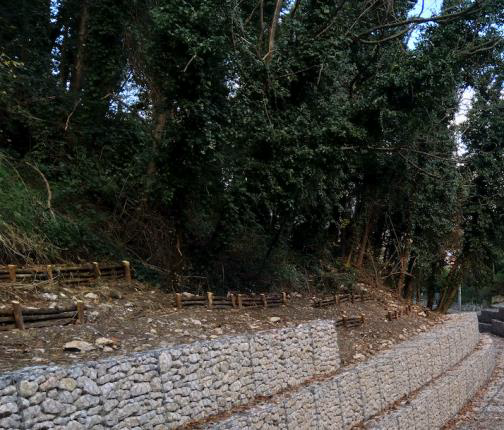Co-designed nature-based solution in Nocera Inferiore, Italy

Summary
This nature-based solution sought to reduce landslide risk in Southern Italy.
This nature-based solution was implemented in the Nocera Inferiore municipality at the foot of the Monte Albino mountain in Southern Italy. It was prompted by the occurrence of previous disasters events, especially the one in 2005 that caused severe damages and the loss of lives at Nocera Inferiore. To avoid similar events from happening at Monte Albino, this solution had the main purpose to reduce landslide risk. At the same time, it also provided a number of co-benefits such as protection of a recreational area by installing several paths at the foot of the mountain, and the provision of new ecosystem services for the community.
The works under the project included maintenance/remediation of the slope and naturalistic engineering works on three channels, including channel lining and vegetated/stone gabions aimed at reducing erosion due to frequent rainfall events. Other minor activities including the construction of small hydraulic measures to retain the debris were also done.
Overview
- Location:
- Implementation sites:
-
- Single country
- Single location
- Mountain region:
-
Monti Lattari
- Province:
-
- Campania/Salermo
- Site locations:
-
Monte Albino (Nocera Inferiore municipality)
- Solution scale:
- Ecosystem type(s):
- Solution type(s):
- Other Solution(s) type(s):
-
- community collaboration
- Sector(s):
- Climate impact(s) addressed:
- Climate impact time-scale(s):
- Main benefit associated with the solution:
- Co-benefit(s) associated with the solution implementation:
- Implementation timeline:
-
- 2012 - 2019
Solution details
Main beneficiaries & outcomes
The main beneficiaries of the solution are local residents located at the slope are of the Monte Albino. Still, other region’s habitants also profit from related co-benefits.
Planning and implementation
Following the Italian legislation, the municipal technical office took charge of the solution implementation, including the public procurement process and the control of the construction works and maintenance.
Most relevant activities/events that lead to implementation:
● 2005: Landslide event on the Monte Sant’Angelo prompted several initiatives among residents. The municipal council opened a forum in the local “Agenda 21” for environmental sustainability to discuss landslide risk management together with representatives of the River Basin Authorities, the Regional Civil Protection, the Regional Department of Soil Defence, the Forest Ranger Corps, and the victims’ committee, several local associations etc. An Emergency Commissariat was established by the Regional Civil Protection.
● 2007 – 2010: Allocation of funds. €2.7 million were allocated for civil protection to the commissariat and it presented a proposal for new structural protection works. This sum later increased to €7.2 million.
● 2010 – 2011: Citizens/public participatory process launched by the SafeLand research project.
Updated landslide hazard analysis and risk estimation.
● 2011: Landslide risk mitigation plan/compromise solution reached as the result of public participatory process.
● 2012-2018: Call for Nature-Based Solutions (NBS) bids/tender process. Decision process of which company would build the solution.
● 2018: Regional funding transferred from the Regional Department for soil defence to the municipality of Nocera Inferiore.
Beginning of NBS construction.
Finance
The cost of the nature-based solution at Monte Albino amounted to €637,000.
Innovation
The resident’s collaboration in the co-design and creation of a compromise solution together with government officials, researchers, experts and other stakeholders. In fact, this aspect was fundamental in the implementation of a nature-based solution for disaster risk reduction instead of a grey one.
Performance evaluation
No information available
Long term project sustainability and maintenance
The municipality is in charge of the maintenance, however, no further information is available regarding the activities to put in place for this purpose.
Capacities for design and implementation
Knowledge
The extensive scientific knowledge of experts participating was a key benefit of the planning and implementation process. In fact, in a questionnaire survey administered at the end of the participatory process, the population stated that their knowledge on landslide risk mitigation measures had improved as well as their awareness on the topic. The involvement of trusted university professors and scientists who presented new and robust scientific evidence and ideas, equally contributed to reconciling different perspectives, and aligned the preferences of citizens and decision-makers for the risk mitigation plan.
Furthermore, the participatory process was only one of the phases of a research completed by the SafeLand project funded by the European Commission. Other activities included case study analysis, questionnaire survey and communication and education activities, all of them highly relevant for facilitating communication and sharing information among residents and other stakeholders.
Technology
Prior to the implementation of the solution, the University of Salerno conducted several studies, including some at a very high resolution, (1:1000 scale). These studies identified 10 mountain basins and 9 open slopes. The hydrographic network was also analysed to complement the landslide hazard analysis and risk estimation, where 520 buildings were mapped in the Monte Albino area.
Political / Legal
There was a mandate for the municipal technical office to implement a nature-based solution, and the rejection of the municipal council for grey approaches (supported by townspeople) was fundamental for the later realization of this measure. The municipal technical office took charge of the implementation. Local politicians also played a critical role in promoting the adoption of this nature-based solution.
Institutional
Several associations mediated and catalysed the local decision-making processes for landslide risk reduction, being crucial to the development of an NBS agenda on which decision-makers were confident enough to take action. They consisted mainly of a small group of environmental and social associations and the landslide victims’ committee (e.g., Montagna Amica/Friends of the mountain, Legambiente, victim’s committee) acted as advocacy coalitions.
Semi-structured interviews with members of these associations allowed a better understanding of their views about landslide risk mitigation and NBS, as some key members acted as mediators, translators, and networkers between different levels (e.g., local government and civil society) and different sectors/domains (e.g., environment, waste management and disaster risk reduction).
Socio-cultural
The social context had an important role in the planning and implementation of the project. Since the beginning of the process, the coalition and participation of interest/pressure groups prioritized the use of a nature-based solution with low environmental impact instead of a grey one. Moreover, the two years participatory process launched by SafeLand which required the cross-collaboration of residents, scientific experts, governments and other stakeholders allowed the agreement on the compromise policy path.
Outlook & Scalability
Barriers and adverse effects
• Opposite views caused conflicts regarding priorities for risk mitigation in Nocera Inferiore. Relocation is a continuous issue and was fiercely opposed by residents and members of the landslide victim committee.
• Conflict between authorities acting at different scales/levels.
• Given the tendency to implement risk mitigation intervention only in the aftermath of a disaster, and because of public rejection of initial proposals, the transferring of risk mitigation funding resulted in a slow process.
• Limited funding. However, this later functioned also as an enabler as it was one of the main reasons of a nature-based solution instead of a grey one.
• Lack of forest development plan and inadequate management of forest mainly due to the fact that forest is both publicly and privately owned.
Transformation and future outlook
Nature-based solutions have a longer lifespan than grey solutions and also help improve ecological resilience. Furthermore, this approach is also a promising strategy for reducing disaster risk, improving ecosystem-based disaster risk reduction, increasing social–ecological resilience, protecting ecosystems, and improving livelihoods through the maintenance, restoration, enhancement, and sustainable use of ecosystems and their services.
Potential for upscaling and replication
Based on available information, no replications have been reported.
- Nature based solutions in-depth case study analysis of the characteristics of successful governance models
- Catalysing innovation: governance enablers of nature-based solutions
- Compromise not consensus: designing a participatory process for landslide risk mitigation
- Expert engagement in participatory processes: translating stakeholder discourses into policy options
- Stakeholders’ perspectives on barriers to landslide risk governance









Comments
There is no content